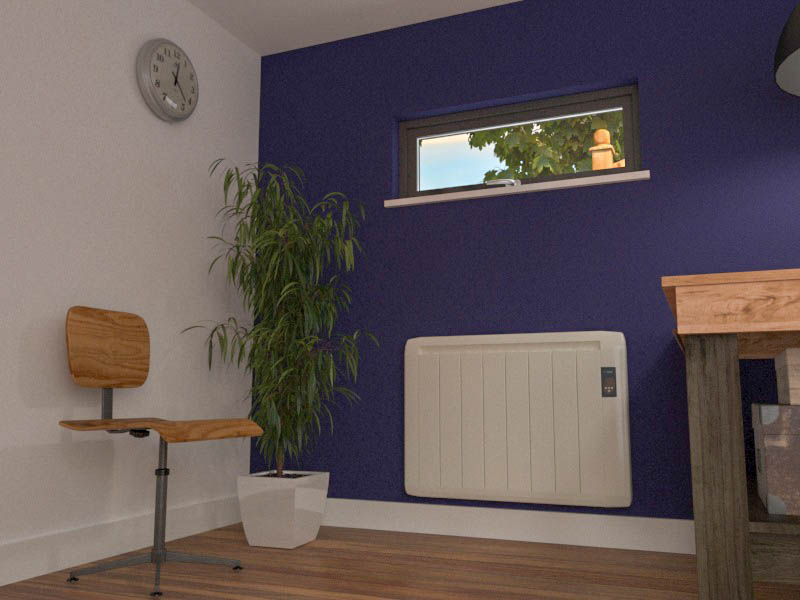Garden office heating
One of the most common questions prospective garden office buyers have is 'are they warm in winter?' Well, if you choose a well insulated and double glazed design and include a source of heating you can be assured it will be.
Not all garden office designs include heating
You need to check that your choice of garden office design includes some form of heating. Some suppliers don't include heating in their package claiming that their designs don't need it. The argument is that their designs are highly insulated and double glazed so are naturally warm. In our 20 year experience of work with, and using a garden office to work from, there have always been days in the depths of winter when we have been very pleased we had heating that we could switch on.
While you can always buy a heater and plug it in. Retrofit heating options are never as successful as systems designed to suit the building. Our advice to you would be to make sure your garden office has heating from day one.
Different types of garden office heating:
- Convector heater
- Oil filled radiator
- Underfloor heating
- Air conditioning
- Infrared heating
- Central heating
- Wood burners

Electric wall panel heaters are commonly the standard heating option offered by garden office companies.
Convector heater
Electric convector heaters are one of the most common forms of garden office heating. They tend to be the standard option offered by most companies. They are chosen because they offer fairly instant heat and units fitted with a timer can be set to come on before you enter the building and switch off when you leave.
Modern convector heaters are narrow units; they usually have a grid on the top and sides from which the warm air blows out. Because the air blows out you need to keep the area around the heater clear of obstruction. The size of the panel used will be worked out based on the cubic capacity of the room. So, a bigger office, you would expect a bigger heater to be used.
The heat from convector heaters is thought by some to dry the air with prolonged use, and they do have a slight hum.
Oil filled radiators
Another popular 'standard' option in garden office design are oil filled radiators. Which are typically freestanding and mounted on wheels so you can easily move them around the room.
These heaters look like old style radiators with large fins; they are filled with oil which heats up to give background heat. , and you can set minimum and maximum temperatures for the room to maintain your ideal temperature. The used to just be available in an off-white finish, but now we see there are black finnishes on offer which look rather sleek.
Underfloor heating
More and more buyers are upgrading from the standard heating options described above, and choosing underfloor heating. A more expensive choice, but because the heating is under the floor, you have maximum flexibility over the positioning of furniture, which people like.
The most common type of underfloor heating used in garden office design is heated matting. This is suitable for fixing on timber subfloors and under the different kinds of floor covering popular in garden office design.
Underfloor heating is a premium option for garden office heating, and if its something that you think will work for you, needs to be specified at the design stage as it is difficult to fit at a later date. Like other forms of heating, you can control the system by setting limits for the temperature, or by setting the timer, so the heating comes on at different times of the day.
Air conditioning
Over the last eighteen months or so, we have noticed that more and more of the buildings we write about have had an air conditioning system fitted. This is partly because the units have come down in price and because of the hot summers and cold winters we have had over the last few years. Buyers want more control.
Although air conditioning is controversial particularly in an eco-friendly construction form like garden offices, it’s worth considering as it can produce a year-round solution to heating and cooling a garden office.
Air conditioning works by taking warm air from within the building and replacing it with cool air, you can set the desired temperature for your garden office, and an air conditioning unit will maintain it all year round.
Air conditioning also offers health benefits as it filters the air removing pollen and pollution making it an ideal system for asthma and hay fever sufferers.
Free standing air conditioning units are available, but they are somewhat cumbersome and have ducting that has to go out of a window, most units used in garden office design consist of a unit positioned high on the wall that is linked to a condenser unit situated outside. The piping between the two units is incorporated into the wall structure.
Air conditioning units use considerable energy and coolants which aren’t great for the environment. To ensure efficiency of the unit doors and windows need to be closed – this takes away one of the delights of a garden office. That of connecting the indoor-outdoor space by having the doors open!
Infrared heating
Where convector and oil filled radiators provide convection heat which heats the whole room, there is another way of heating a garden office - radiant heat. With radiant heat, only the people in the room are heated.
Infrared heating is a form of radiant heat. Infrared heaters are quite thin and discreet units, in fact, some have the appearance of mirrors on the wall. These units can either be fitted on the wall or discreetly on the ceiling of the room.
Infrared heating is a fast and energy efficient form of heating because its only warming people not furniture etc., but has the downside that you really need to be in line with the heater to benefit most so isn't ideal if you are moving around the room a lot.
Central heating
It's rare, but not uncommon for us to hear about bespoke garden office designs which have central heating systems. These are normally large buildings and have either been near enough to the house to connect to the main central heating system, or they have had their own boiler installed.
This is an expensive option, so therefore not common, but does allow you to heat the room using conventional radiators.
Wood burner
It is possible to install a wood burner in a garden office, and it would make an excellent focal point in the room. The installation of a wood burner needs to be undertaken by professionals and comply with Building Regulations. For this reason, a garden office designer will normally ask you to organise this separately. They will, however, liaise with the installer to incorporate the chimney into the roof structure and ensure there is sufficient ventilation in the build-up.
While a wood burner would look great, compared to other forms of heating a wood burner is expensive to install in a garden office. Also, it could be difficult to control the heat given off in smaller buildings. Wood burners are not instant heat sources, and you have the work involved in cleaning the stove.
Timers, thermostats and remote controls
To ensure energy efficiency and so that you are warm when you want to be, you need to ensure that your chosen heating system has a thermostat fitted. This will allow you to control the temperature in the room, in many cases, you can set minimum and maximum temperatures for your office so that the heating kicks in and turns itself off at set points.
Another way to control your garden office heating is to have a timer control. This is useful in the winter as you can set the heating to switch on and warm the room before you arrive for work. It then switches off as you leave. This means you will not be wasting energy or money when you're not in the building.
Its pretty standard practice to have a timer fitted to the offices heating, but some suppliers go a step further and provide ways of controlling the heating remotely. Some systems have remote control units that allow you to switch the heating off from inside your house and control the temperature in the office. Other methods are more sophisticated and can be controlled by your smartphone; this will give you a greater range of control. There are some systems which can be controlled by home automation systems such as Amazon Eco and Google home. This would allow you to say 'Alexa, turn on the garden office heating' - a nifty feature for the tech lover!

